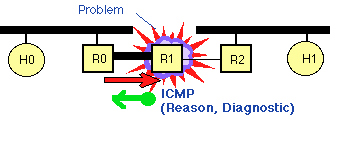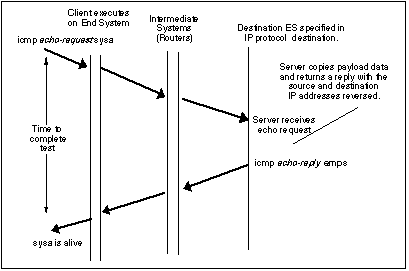

An ICMP message consisting of 4 bytes of PCI and an optional message payload.
The format of an ICMP message is shown above. The 8-bit type code identifies the types of message. This is followed by at least the first 28 bytes of the packet that resulted in generation of the error message (i.e. the network-layer header and first 8 bytes of transport header). This payload is, for instance used by a sender that receives the ICMP message to perform Path MTU Discovery so that it may determine IP destination address of the packet that resulted in the error. Longer payloads are also encouraged (which can help better identify the reason why the ICMP message was generated and which program generated the original packet).The figure below shows the encapsulation of ICMP over an Ethernet LAN using an IP network layer header, and a MAC link layer header and trailer containing the 32-bit checksum:

Encapsulation for a complete ICMP packet (not showing the Ethernet preamble)
It is the responsibility of the network layer (IP) protocol to ensure that the ICMP message is sent to the correct destination. This is achieved by setting the destination address of the IP packet carrying the ICMP message. The source address is set to the address of the computer that generated the IP packet (carried in the IP source address field) and the IP protocol type is set to "ICMP" to indicate that the packet is to be handled by the remote end system's ICMP client interface.
RFC792 specifies the Internet Control Message Protocol (ICMP) that is used with the Internet Protocol version 4 (IPv4). It defines, among other things, a number of error messages that can be used by an end-system and intermediate systems to report errors back to the sending system. The host requirements (RFC1122) classifies ICMP these error messages into those that indicate "soft errors" (advising of problems), and those that indicate "hard errors" (which need to be responded to).
A version of ICMP has also been defined for IPv6, called ICMPv6 (RFC4443). This subsumes all the equivalent functions of ICMP for IPv4 and adds other network-layer functions. ICMP error messages are up to 1280 bytes in size, and therefore always carry a substantial number of bytes from the packet that generated the error being reported.
RFC792 specifies the Internet Control Message Protocol (ICMP) that is used with the Internet Protocol version 4 (IPv4). It defines, among other things, a number of error messages that can be used by an end-system and intermediate systems to report errors back to the sending system. The host requirements (RFC1122) classifies ICMP these error messages into those that indicate "soft errors" (advising of problems), and those that indicate "hard errors" (which need to be responded to).
A version of ICMP has also been defined for IPv6, called ICMPv6 (RFC4443). This subsumes all the equivalent functions of ICMP for IPv4 and adds other network-layer functions. ICMP error messages are up to 1280 bytes in size, and therefore always carry a substantial number of bytes from the packet that generated the error being reported.
The Ping Application
The "ping" program contains a client interface to ICMP. It may be used by a user to verify an end-to-end Internet Path is operational. The ping program also collects performance statistics (i.e. the measured round trip time and the number of times the remote server fails to reply. Each time an ICMP echo reply message is received, the ping program displays a single line of text. The text printed by ping shows the received sequence number, and the measured round trip time (in milliseconds). Each ICMP Echo message contains a sequence number (starting at 0) that is incremented after each transmission, and a timestamp value indicating the transmission time.
Use of the ping program to test whether a particular computer ("sysa") is operational.
The operation of ICMP is illustrated in the frame transition diagram shown above. In this case there is only one Intermediate System (IS) (i.e. IP router). In this case two types of message are involved the ECHO request (sent by the client) and the ECHO reply (the response by the server). Each message may contain some optional data. When data are sent by a server, the server returns the data in the reply which is generated. ICMP packets are encapsulated in IP for transmission across an internet.The Traceroute Application
The "traceroute" program also contains a client interface to ICMP. Like the "ping" program, it may be used by a user to verify an end-to-end Internet Path is operational, but also provides information on each of the Intermediate Systems (i.e. IP routers) to be found along the IP Path from the sender to the receiver. Traceroute uses ICMP echo messages. These are addressed to the target IP address. The sender manipulates the TTL (hop count) value at the IP layer to force each hop in turn to return an error message.- The program starts by sending an ICMP Echo request message with an IP destination address of the system to be tested and with a Time To Live (TTL) value set to 1. The first system that receives this packet decrements the TTL and discards the message, since this now has a value of zero. Before it deletes the message, the system constructs an ICMP error message (with an ICMP message type of "TTL exceeded") and returns this back to the sender. Receipt of this message allows the sender to identify which system is one link away along the path to the specified destination.
- The sender repeats this two more times, each time reporting the system that received the packet. If all packets travel along the same path, each ICMP error message will be received from the same system. Where two or more alternate paths are being used, the results may vary.
- If the system that responded was not the intended destination, the sender repeats the process by sending a set of three identical messages, but using a TTL value that is one larger than the previous attempt. The first system forwards the packet (decrementing the TTL value in the IP header), but a subsequent system that reduces the TTL value to zero, generates an ICMP error message with its own source address. In this way, the sender learns the identity of another system along the IP path to the destination.
- This process repeats until the sender receives a response from the intended destination (or the maximum TTL value is reached).
- Some Routers are configured to discard ICMP messages, while others process them but do not return ICMP Error Messages. Such routers hide the "topology" of the network, but also can impact correct operation of protocols. Some routers will process the ICMP Messages, providing that they do not impose a significant load on the routers, such routers do not always respond to ICMP messages. When "traceroute" encounters a router that does not respond, it prints a "*" character.
No comments:
Post a Comment